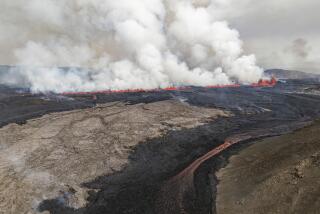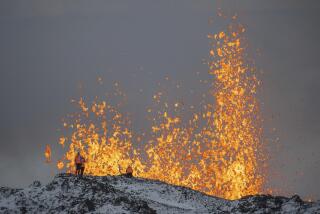Bathers Take Plunge in Iceland’s Steamy Blue Lagoon
- Share via
GRINDAVIK, Iceland — If nothing else, the Blue Lagoon proves that with a little creative marketing, industrial byproducts can be chic.
The lagoon is full of liquid runoff from one of Iceland’s big geothermal power plants. But rather than let the hot, salty water just sit there, an investor group built some beaches, added deck chairs and invited people to come soak.
Thus, the water discharged from Sudurnes Regional Heating Plant became the Blue Lagoon, a sparkling aqua spa. It’s not only soothing, the owners say, but good for your skin.
The idea of bathing in the shadow of a humming power plant, amid the strong smell of sulfur, elicits mixed reviews from visitors.
“It’s not pretty,” said Eric Bouby, from Les Essarts-le-Roi, France. “It’s a factory.”
He and his wife, Daniele, stayed out while their 14-year-old son, Julien, plunged right in. “It’s foggy and it’s too hot,” Daniele Bouby said.
Others find a dip in the Blue Lagoon, at $5.20 per day, invigorating.
“It smells bad, like rotten eggs,” said Hanna Winberg, visiting from Linkoping, Sweden. “But it is nice. It’s warm and relaxing. All this steam is extraordinary.”
*
When the wind drifts toward the shallow end, the spa is suddenly enveloped in a cloud of steam, belching out of the pipes at the power plant and shrouding everybody in a warm but fuzzy blur.
Another shift of the wind, and the bathers reappear in a blast of cool air, with a full view of the green mountains on the other side of Iceland’s Highway 43. The water is a striking blue, thanks to high concentrations of silica, minerals and algae.
“Some people find it exciting,” said Grimur Saemundson, managing director of Blue Lagoon Ltd. “Others find it a bit appalling.”
Despite the naysayers, the Blue Lagoon is one of Iceland’s more popular tourist attractions, complete with a 23-room hotel. Some 130,000 people visited the lagoon last year, and the numbers were up by 20% for the first six months of 1996.
Now operators are planning a new and better, if not bluer, lagoon. The power plant, which provides electricity and hot water for 25,000 Icelanders, is expanding, and as the plant gets bigger, so will the lagoon.
Some $10.4 million in improvements are planned by the shareholders, who include the state-run power plant; a big construction group, Iceland Prime Contractors; and some smaller private investors from Iceland’s capital Reykjavik.
The Blue Lagoon is profitable, Saemundson says, but the company does not disclose any details. “We are happy with the way things are going, but again, we are investing a lot,” he said.
Steam clouds willing, the new Blue Lagoon will appear in spring 1998, complete with a conference center and restaurants. And the power plant will be somewhat less apparent, as the new design calls for it to be blocked from the bathers’ view.
“The image of the geothermal power station will fade out, but you will never exclude the power station because the power station is the origin of the Blue Lagoon,” Saemundson said.
And the sulfur smell?
“I don’t know how it will be in the new area,” Saemundson said. He’s not even sure where the sulfur odors come from, though he insists they are milder than those found in other areas of major geothermal activity in Iceland.
Blue Lagoon operators say bathing in the runoff is good for people with psoriasis and other skin ailments. Although this was an accidental discovery by a bather several years ago, Icelandic health authorities now recognize the lagoon as a place with bona fide healing powers.
The Blue Lagoon owners have researched their mineral-rich waters and developed a range of Blue Lagoon products such as bath salts, mud and moisturizing cream.
This no doubt is their only shot at selling the Blue Lagoon experience to people too squeamish to step into the sulfury bath.
More to Read
Sign up for The Wild
We’ll help you find the best places to hike, bike and run, as well as the perfect silent spots for meditation and yoga.
You may occasionally receive promotional content from the Los Angeles Times.






